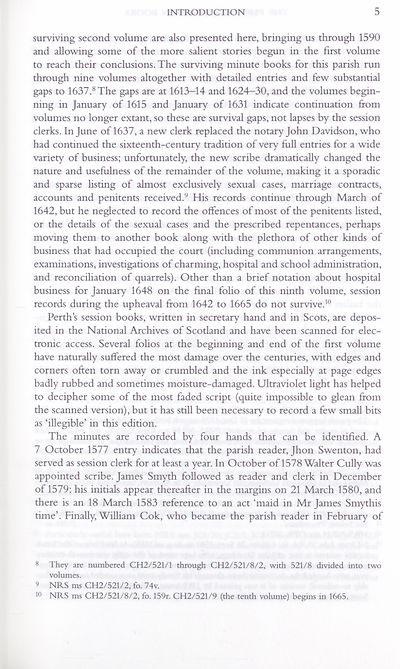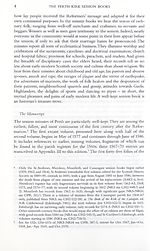Series 6 > Perth Kirk Session books, 1577-1590
(20) Page 5
Download files
Complete book:
Individual page:
Thumbnail gallery: Grid view | List view

INTRODUCTION
5
surviving second volume are also presented here, bringing us through 1590
and allowing some of the more sahent stories begun in the first volume
to reach their conclusions. The surviving minute books for this parish run
through nine volumes altogether with detailed entries and few substantial
gaps to 1637.8 The gaps are at 1613-14 and 1624—30, and the volumes begin¬
ning in January of 1615 and January of 1631 indicate continuation from
volumes no longer extant, so these are survival gaps, not lapses by the session
clerks. In June of 1637, a new clerk replaced the notary John Davidson, who
had continued the sixteenth-century tradition of very full entries for a wide
variety of business; unfortunately, the new scribe dramatically changed the
nature and usefulness of the remainder of the volume, making it a sporadic
and sparse Usting of almost exclusively sexual cases, marriage contracts,
accounts and penitents received.9 His records continue through March of
1642, but he neglected to record the offences of most of the penitents fisted,
or the details of the sexual cases and the prescribed repentances, perhaps
moving them to another book along with the plethora of other kinds of
business that had occupied the court (including communion arrangements,
examinations, investigations of charming, hospital and school administration,
and reconciliation of quarrels). Other than a brief notation about hospital
business for January 1648 on the final folio of this ninth volume, session
records during the upheaval from 1642 to 1665 do not survive.10
Perth’s session books, written in secretary hand and in Scots, are depos¬
ited in the National Archives of Scotland and have been scanned for elec¬
tronic access. Several folios at the beginning and end of the first volume
have naturally suffered the most damage over the centuries, with edges and
corners often torn away or crumbled and the ink especially at page edges
badly rubbed and sometimes moisture-damaged. Ultraviolet fight has helped
to decipher some of the most faded script (quite impossible to glean from
the scanned version), but it has still been necessary to record a few small bits
as ‘illegible’ in this edition.
The minutes are recorded by four hands that can be identified. A
7 October 1577 entry indicates that the parish reader, Jhon Swenton, had
served as session clerk for at least a year. In October of1578 Walter Cully was
appointed scribe. James Smyth followed as reader and clerk in December
of 1579: his initials appear thereafter in the margins on 21 March 1580, and
there is an 18 March 1583 reference to an act ‘maid in Mr James Smythis
time’. Finally, William Cok, who became the parish reader in February of
8 They arc numbered CH2/521/1 through CH2/521/8/2, with 521/8 divided into two
volumes.
9 NRS ms CH2/521/2, fo. 74v.
10 NRS ms CH2/521/8/2, fo. 159r. CH2/521/9 (the tenth volume) begins in 1665.
5
surviving second volume are also presented here, bringing us through 1590
and allowing some of the more sahent stories begun in the first volume
to reach their conclusions. The surviving minute books for this parish run
through nine volumes altogether with detailed entries and few substantial
gaps to 1637.8 The gaps are at 1613-14 and 1624—30, and the volumes begin¬
ning in January of 1615 and January of 1631 indicate continuation from
volumes no longer extant, so these are survival gaps, not lapses by the session
clerks. In June of 1637, a new clerk replaced the notary John Davidson, who
had continued the sixteenth-century tradition of very full entries for a wide
variety of business; unfortunately, the new scribe dramatically changed the
nature and usefulness of the remainder of the volume, making it a sporadic
and sparse Usting of almost exclusively sexual cases, marriage contracts,
accounts and penitents received.9 His records continue through March of
1642, but he neglected to record the offences of most of the penitents fisted,
or the details of the sexual cases and the prescribed repentances, perhaps
moving them to another book along with the plethora of other kinds of
business that had occupied the court (including communion arrangements,
examinations, investigations of charming, hospital and school administration,
and reconciliation of quarrels). Other than a brief notation about hospital
business for January 1648 on the final folio of this ninth volume, session
records during the upheaval from 1642 to 1665 do not survive.10
Perth’s session books, written in secretary hand and in Scots, are depos¬
ited in the National Archives of Scotland and have been scanned for elec¬
tronic access. Several folios at the beginning and end of the first volume
have naturally suffered the most damage over the centuries, with edges and
corners often torn away or crumbled and the ink especially at page edges
badly rubbed and sometimes moisture-damaged. Ultraviolet fight has helped
to decipher some of the most faded script (quite impossible to glean from
the scanned version), but it has still been necessary to record a few small bits
as ‘illegible’ in this edition.
The minutes are recorded by four hands that can be identified. A
7 October 1577 entry indicates that the parish reader, Jhon Swenton, had
served as session clerk for at least a year. In October of1578 Walter Cully was
appointed scribe. James Smyth followed as reader and clerk in December
of 1579: his initials appear thereafter in the margins on 21 March 1580, and
there is an 18 March 1583 reference to an act ‘maid in Mr James Smythis
time’. Finally, William Cok, who became the parish reader in February of
8 They arc numbered CH2/521/1 through CH2/521/8/2, with 521/8 divided into two
volumes.
9 NRS ms CH2/521/2, fo. 74v.
10 NRS ms CH2/521/8/2, fo. 159r. CH2/521/9 (the tenth volume) begins in 1665.
Set display mode to:
![]() Universal Viewer |
Universal Viewer | ![]() Mirador |
Large image | Transcription
Mirador |
Large image | Transcription
Images and transcriptions on this page, including medium image downloads, may be used under the Creative Commons Attribution 4.0 International Licence unless otherwise stated. ![]()
| Scottish History Society volumes > Series 6 > Perth Kirk Session books, 1577-1590 > (20) Page 5 |
|---|
| Permanent URL | https://digital.nls.uk/127280877 |
|---|
| Description | Over 180 volumes, published by the Scottish History Society, containing original sources on Scotland's history and people. With a wide range of subjects, the books collectively cover all periods from the 12th to 20th centuries, and reflect changing trends in Scottish history. Sources are accompanied by scholarly interpretation, references and bibliographies. Volumes are usually published annually, and more digitised volumes will be added as they become available. |
|---|


